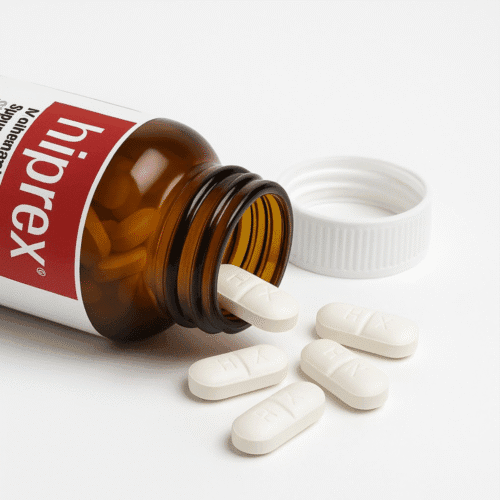Methenamine hippurate (formerly hexamine hippurate) is a substance used to treat or prevent urinary tract infections (UTIs).
In urine, methenamine breaks down (hydrolyses) into formaldehyde, which has an antimicrobial effect on bacteria and fungi in the bladder and urinary tract.1
Methenamine (Hiprex) can be a very useful adjunct to other chronic urinary tract infection treatments, possibly within a week or when used for a long period of time.
Methenamine suppresses or eliminates bacteria in the urine (bacteriuria), particularly associated with kidney inflammation (pyelonephritis), bladder inflammation (cystitis), and chronic urinary tract infection.
Methenamine is often used to keep UTI symptoms at bay in those with neurological diseases (the neurogenic bladder), though there is some evidence that, unfortunately, it doesn’t work as well in those patients.
Methenamine treats or manages urinary tract infections and may suppress UTI in those with intermittent catheter use.2
What bacteria and fungi are killed by methenamine/Hiprex?
Almost all bacteria and fungi are killed by Hiprex, and microbes do not develop resistance to this treatment, unlike antibiotics.3
Don’t use methenamine (Hiprex) when:
Hiprex can’t work in alkaline urine – a pH of 5.5 or below is required, so using methenamine while concurrently using urinary alkalisers is out of the question. If this pH is impossible to achieve, treatment with methenamine will not work.
If a person has a permanent (indwelling) urinary catheter, methenamine is also ineffective. Caution in those who are dehydrated or have impaired kidneys or liver.
How to use Hiprex effectively
Follow the directions on the jar, which will be tailored to the type of methenamine you are taking. A full course of therapy is advised. If you miss a dose, don’t double up the next dose, but take it as soon as possible or skip a dose if it is near to the next dose.
If symptoms do not improve, see a doctor.
How to keep urine acidic during treatment with Hiprex
Acidic urine is essential for methenamine treatment to work, but it’s easy to do. Eat plenty of protein, cranberries, vitamin C (ascorbic acid), plums or prunes.
If you want to check your urinary pH (which you should because it’s fun), find a local pharmacy that sells pH tester paper or strips. PH strips are inexpensive and come in packs. You want strips that have the numbers from about 4-9, in 0.5 increments if possible.
Your pH must remain at 5.5 or lower (with low numbers meaning high acidity). You can also take vitamin C (ascorbic acid) (but avoid anything with ascorbate sodium, as it is alkalising), up to 4 grams per day.
Watch for diarrhoea since vitamin C draws water to the bowel. Maintain fluid levels.

Some bacteria (urea-splitting organisms like Proteus mirabilis and some strains of Pseudomonas and Enterobacter) can increase urinary pH, interfering with methenamine action. It’s important to measure urinary pH while taking methenamine.
Maintenance doses of Hiprex/methenamine
If urinary tract infections are successfully prevented using 4 grams of methenamine mandelate daily, reduce the dose to a maintenance level of 1 gram twice daily.4 Check it is working as desired.
What is methenamine?
Methenamine is what’s known as a weak base. After ingestion, and once in the bladder, methenamine breaks down into two parts: ammonia and formaldehyde, a known nonspecific antibacterial agent.
How does formaldehyde work?
It is thought that formaldehyde works by damaging (denaturing) microbe proteins and killing them. The pH (acidity) controls the amount of formaldehyde released, so the more acidic the urine, the more formaldehyde is released and the more powerful the antimicrobial effect.
The flow rate and volume of urine also make a difference in the effectiveness of these treatments.
Methenamine is freely distributed in body tissues and fluids, but this is apparently not clinically significant since methenamine does not break down at a pH over 6.8 – human tissue has a pH of 7.2. Saliva and urine have a normal pH of between 6.6 and 6.8.
Digestion and the different forms of methenamine
The tablets may be enteric-coated (methenamine mandelate), which prevents the tablet from dissolving in your acidic stomach, but instead makes it as far as possible down the intestine and into the body tissues.
We recommend using enteric-coated tablets if you can. You don’t want formaldehyde in your digestive tract.
But, the tablets may not be coated. Methenamine alone will be rapidly absorbed, but 30-60 per cent will be hydrolysed by stomach acid.
Methenamine hippurate is rapidly absorbed via the gastrointestinal tract. Some formaldehyde is bound to substances in urine and surrounding tissues. Formaldehyde has a half-life of 4.3 hours and is excreted via the kidneys almost completely (90 per cent) within 24 hours.
The peak of the urinary formaldehyde concentration (with a pH of 5.6) is as follows:
- Methenamine – 0.5-1.5 hours
- Methenamine hippurate – 2 hours
- Methenamine mandelate (enteric-coated tablets) 3-8 hours.
People with impaired kidney function and use of methenamine
Methenamine can accumulate in the body when the kidneys are not functioning properly, but it does not hydrolyse in blood (which has a pH of 7.4), and is not considered toxic.5
Hippuric acid and mandelic acid can accumulate in those with severely impaired kidney function and could be toxic. In people with impaired kidney function, formaldehyde concentrations may not be sufficient to work as expected.
Care should be taken in those with kidney impairment, with crystalluria (crystals in the urine) a risk with low urinary output.
Precautions when using methenamine
Pregnancy and fertility considerations
Methenamine crosses the placenta, but the study is still insufficient in animals and humans. There has been no demonstrated risk of foetal abnormalities during pregnancy when using methenamine. Methenamine is considered an FDA Pregnancy Category C.6,7
Category C means, “Animal reproduction studies have shown an adverse effect on the foetus and there are no adequate and well-controlled studies in humans, but potential benefits may warrant the use of the drug in pregnant women despite potential risks.”
Breastfeeding/lactating and use of methenamine
Methenamine is found in breast milk, but no problems have been recorded so far.
Children (paediatrics) and use of methenamine
No problems have been yet identified regarding methenamine and children, but it is recommended for use in children 12 years and above.
Elderly (geriatrics) and use of methenamine
In one study8, 52 elderly hospitalised patients (age 66+) were treated for urinary tract infection with antibiotics (7-10 days) and then methenamine (1g daily for six months). Those treated with Hiprex had far fewer reinfections than in the previous six months. There were no adverse reactions and bacteria did not become resistant.9
Liver impairment with use of methenamine
Those with severe liver impairment should seek medical guidance when using this drug.
Use with other drugs or supplements (drug interactions) with methenamine
- Urinary alkalisers – don’t use (methenamine needs acidity to work)
- Antacids (methenamine needs acidity to work)
- Carbonic anhydrase inhibitors
- Citrates
- Sodium bicarbonate, or
- Diuretics, thiazide
- Sulfamethizole (may increase the risk of crystalluria)
- Don’t use with Azulfidine, Bactrim, Septra, SMZ-TMP, Sulfazine, and others
Side-effects of methenamine
Note: large, ongoing doses of methenamine (8 grams per day for 3-4 weeks) have caused bladder irritation, painful and frequent urination, and blood in the urine.
Infrequent side effects include skin rashes, and rarely, methenamine can cause crystalluria or hematuria – those are characterised by blood in the urine, lower back pain, and pain or burning on urination.
Methenamine can sometimes cause nausea and vomiting. Sometimes, methenamine can cause painful urination – adjust the dose accordingly. If side effects occur, take Hiprex after meals or at bedtime.
Getting support for chronic UTI
My Vagina’s clinical naturopaths work with people with chronic UTI daily and can help you resolve chronic urinary tract infections.
Our experienced practitioners use non-drug non-resistance-forming strategies that can work concurrently with antibiotics as needed, using an integrative, holistic framework.10 We aim to reduce antibiotic use as much as possible with effective solutions for urinary tract infections.
Can cranberry treat bacterial vaginosis?
Discover how high-PAC cranberry supports vaginal wellness by reducing UTI-related BV flare-ups — not by curing BV, but by breaking the cycle.
Cranberry and UTIs: what actually works
Cranberry has a long history of use in UTI, but not all supplements are created equal. Learn how cranberry works and how to choose a great product.
Hiprex is Pharmacy Only, what now?
On October 1, 2025, Hiprex, a trusted UTI preventative, became restricted in Australia. Discover alternatives and expert insights for effective care.
References11
- 1.Heltveit-Olsen SR, Sundvall PD, Gunnarsson R, et al. Methenamine hippurate to prevent recurrent urinary tract infections in older women: protocol for a randomised, placebo-controlled trial (ImpresU). BMJ Open. Published online November 2022:e065217. doi:10.1136/bmjopen-2022-065217
- 2.Tam TY, Aldrich ER, Crisp CC, Yook E, Yeung J, Pauls RN. Methenamine Hippurate With Cranberry Capsules Versus Cranberry Alone for Urinary Tract Infection Prevention in a Short-Term Indwelling Foley Catheter Population After Urogynecologic Surgery: A Double-Blinded Randomized Controlled Trial. Female Pelvic Med Reconstr Surg. Published online March 2022:e55-e61. doi:10.1097/spv.0000000000001147
- 3.Harding C, Chadwick T, Homer T, et al. Methenamine hippurate compared with antibiotic prophylaxis to prevent recurrent urinary tract infections in women: the ALTAR non-inferiority RCT. Health Technol Assess. Published online May 2022:1-172. doi:10.3310/qoiz6538
- 4.Hobaica NC, De Oliveira GC, Porto BC, et al. Effectiveness of methenamine hippurate in preventing urinary tract infections: an updated systematic review, meta-analysis and trial sequential analysis of randomized controlled trials. BMC Urol. Published online February 15, 2025. doi:10.1186/s12894-025-01708-8
- 5.Hollyer I, Varias F, Ho B, Ison MG. Safety and efficacy of methenamine hippurate for the prevention of recurrent urinary tract infections in adult renal transplant recipients: A single center, retrospective study. Transplant Infectious Dis. Published online March 8, 2019. doi:10.1111/tid.13063
- 6.Davidson SM, Brown JN, Nance CB, Townsend ML. Use of Methenamine for Urinary Tract Infection Prophylaxis: Systematic Review of Recent Evidence. Int Urogynecol J. Published online February 8, 2024:483-489. doi:10.1007/s00192-024-05726-2
- 7.Lo TS, Hammer KD, Zegarra M, Cho WC. Methenamine: a forgotten drug for preventing recurrent urinary tract infection in a multidrug resistance era. Expert Review of Anti-infective Therapy. Published online April 2014:549-554. doi:10.1586/14787210.2014.904202
- 8.Parvio S. Methenamine Hippurate (‘Hiprex’)† in the Treatment of Chronic Urinary Tract Infections: A Trial in a Geriatric Hospital. J Int Med Res. Published online March 1976:111-114. doi:10.1177/030006057600400205
- 9.Chwa A, Kavanagh K, Linnebur SA, Fixen DR. Evaluation of methenamine for urinary tract infection prevention in older adults: a review of the evidence. Therapeutic Advances in Drug Safety. Published online January 2019. doi:10.1177/2042098619876749
- 10.Sihra N, Malde S, Greenwell T, Pakzad M, Kujawa M, Sinclair A. Management of recurrent urinary tract infections in women. Journal of Clinical Urology. Published online July 20, 2020:152-164. doi:10.1177/2051415820939456
- 11.Lee B, Bhuta T, Craig J, Simpson J. Methenamine hippurate for preventing urinary tract infections. Lee BSB, ed. The Cochrane Database of Systematic Reviews (Protocol). Published online January 21, 2002. doi:10.1002/14651858.cd003265

Get a fresh perspective with a qualified, experienced vulvovaginal specialist naturopath.
This product has multiple variants. The options may be chosen on the product page
The most comprehensive vaginal microbiome test you can take at home, brought to you by world-leading vaginal microbiome scientists at Juno Bio.
Easy-to-use BV and AV treatment program.

Promote and support a protective vaginal microbiome with tailored probiotic species.









